A biology lab manual serves as a comprehensive guide for conducting experiments, providing structured procedures, safety protocols, and critical thinking exercises to enhance hands-on learning experiences․
1․1 Overview of Biology Lab Manuals
Biology lab manuals are structured guides that outline experiments, procedures, and activities for students to explore biological concepts hands-on․ They typically include detailed instructions, safety protocols, and pre-lab questions to prepare students․ These manuals often feature visual aids like diagrams and photographs to enhance understanding․ Designed for both students and educators, they cater to various skill levels, from introductory courses to advanced studies․ Many manuals emphasize critical thinking and real-world applications, making them adaptable to different educational settings and course requirements․
1․2 Importance of Lab Manuals in Biology Education
Lab manuals are essential in biology education as they provide structured, hands-on learning experiences; They help students develop practical skills, critical thinking, and scientific literacy․ By guiding students through experiments and procedures, manuals reinforce theoretical concepts and prepare them for real-world applications․ They also promote safety awareness and proper laboratory practices․ Manuals designed for various educational levels ensure that students can engage with content tailored to their needs, fostering a deeper understanding of biological principles and encouraging active participation in the scientific process․
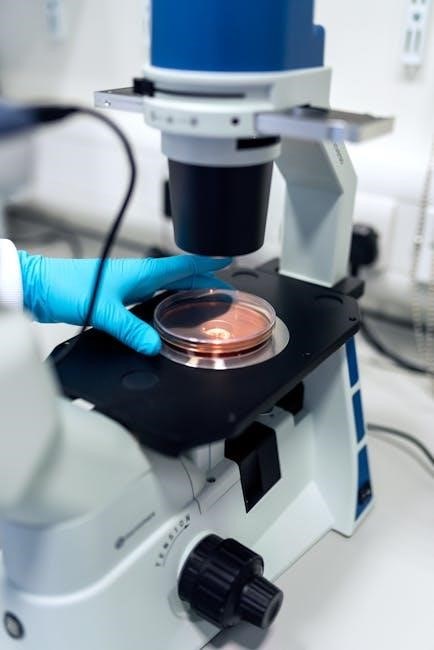
Key Components of a Biology Lab Manual
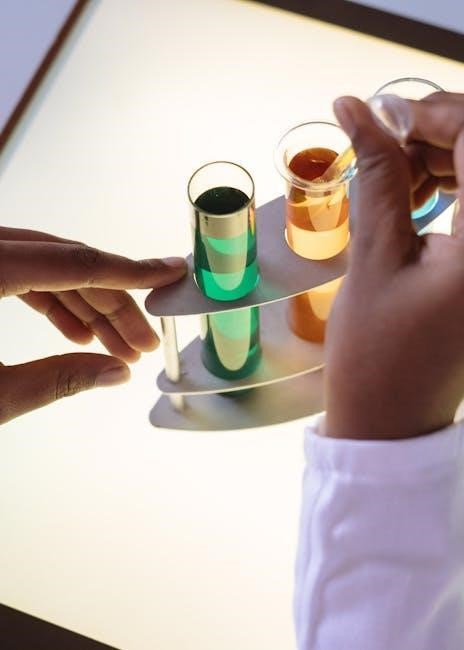
Biology lab manuals include safety protocols, essential equipment, step-by-step procedures, and pre/post-lab questions to guide students through experiments, ensuring a structured and effective learning experience․
2․1 Laboratory Safety Protocols
Laboratory safety protocols are crucial for protecting students and staff from potential hazards․ These include proper handling of biological specimens, chemical safety measures, and waste disposal guidelines․ Emergency procedures, such as fire evacuation plans and first aid kits, are also emphasized․ Students are required to wear protective gear like gloves and goggles․ Safety icons and cautions are highlighted in manuals to ensure awareness․ Adhering to these protocols minimizes risks and fosters a secure environment for conducting experiments and investigations․
2․2 Essential Laboratory Equipment
Essential laboratory equipment includes microscopes for observing specimens, thermometers for temperature measurements, and centrifuges for separating substances․ Spectrophotometers and pH meters are used for chemical analyses․ Pipettes, beakers, and Petri dishes are fundamental for handling liquids and cultures․ Incubators maintain controlled environments for cell growth, while microtomes prepare thin sections for microscopy․ These tools are indispensable for conducting experiments safely and accurately, ensuring precise results in biological investigations․
2․3 Pre-Lab and Post-Lab Questions
Pre-lab questions prepare students by focusing on objectives, materials, and concepts, ensuring a solid foundation before starting experiments․ Post-lab questions reinforce learning by analyzing data, interpreting results, and applying concepts to real-world scenarios․ These questions encourage critical thinking, integration of ideas, and reflection on experimental outcomes․ They also guide students in identifying patterns, evaluating procedures, and understanding the significance of their findings, fostering a deeper understanding of biological principles and their practical applications․
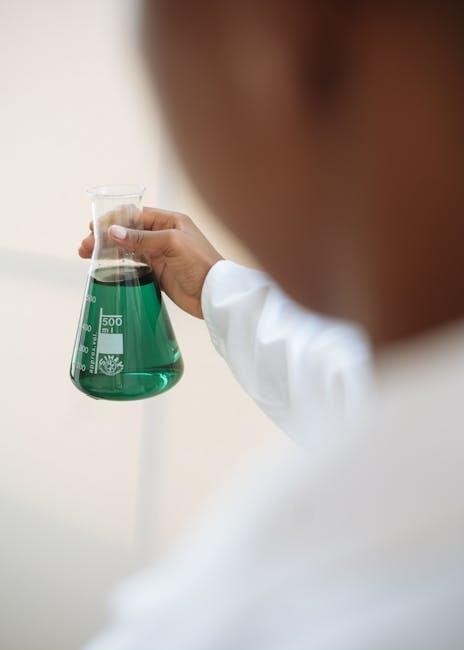
Introductory Biology Lab Techniques
Introductory biology lab techniques focus on foundational skills such as microscopy, specimen preparation, and basic measurements․ These hands-on methods help students understand biological structures and processes effectively․
3․1 Microscopy and Specimen Preparation
Microscopy and specimen preparation are fundamental techniques in biology labs, enabling students to study microscopic structures․ Proper specimen preparation involves fixation, staining, and mounting to ensure clear observations․ Students learn to use compound and stereo microscopes, focusing on resolution and magnification․ Safety protocols are emphasized to handle equipment and biological samples responsibly․ These exercises foster critical thinking and precision, essential for understanding cellular and tissue structures․ Effective specimen preparation is key to accurate observations, making microscopy a cornerstone of introductory biology techniques․
3․2 Cell Structure and Function Experiments
Cell structure and function experiments introduce students to the fascinating world of cellular biology․ Activities include observing live cells, comparing prokaryotic and eukaryotic cells, and studying organelle functions․ Students explore cellular transport mechanisms like osmosis and diffusion, gaining insights into how cells maintain homeostasis․ These experiments often involve staining techniques to visualize cell components and interactive simulations to model cellular processes․ By analyzing cell structure and function, students develop a deeper understanding of life’s fundamental units and their roles in organisms․ These hands-on exercises enhance analytical and problem-solving skills in biology․
3․3 Basic Laboratory Measurements
Mastering basic laboratory measurements is essential for accurate scientific inquiry in biology․ Students learn to use microscopes to measure cell dimensions, calculate population densities, and perform precise volume measurements using pipettes․ These exercises emphasize the importance of data recording, unit conversions, and maintaining accuracy․ Activities also include determining pH levels, analyzing solutions, and understanding dilution techniques․ By mastering these fundamental skills, students build a strong foundation for conducting precise and reliable experiments, ensuring data integrity and reproducibility in their biological studies․

Advanced Biology Lab Experiments
Advanced lab experiments explore complex topics like genetics, ecology, and dissection, offering hands-on experience with modern techniques and fostering deeper understanding of biological systems and processes․
4․1 Genetics and DNA Analysis
Genetics and DNA analysis experiments introduce students to modern molecular biology techniques, such as PCR (Polymerase Chain Reaction) and gel electrophoresis․ These labs enable the study of genetic inheritance, DNA structure, and gene expression․ Students learn to extract, amplify, and analyze DNA, preparing them for advanced research in genetics․ Practical applications include genetic testing, DNA sequencing, and forensic analysis․ These experiments foster a deeper understanding of genetic principles and their real-world implications, equipping students with essential skills for careers in genetics, biotechnology, and medical research․
4․2 Ecology and Environmental Studies
Ecology and environmental studies labs focus on understanding interactions between organisms and their ecosystems․ Experiments include measuring biodiversity, analyzing water quality, and studying population dynamics․ Students explore ecological principles through field and laboratory investigations, developing skills in data collection and analysis․ Labs often incorporate real-world applications, such as assessing environmental impacts and designing conservation strategies․ These exercises foster an appreciation for sustainability and prepare students to address global environmental challenges, promoting stewardship of natural resources and ecosystems․
4․3 Dissection and Anatomy Studies
Dissection and anatomy studies provide hands-on experience in exploring the structure and function of biological organisms․ Labs typically involve dissecting plant and animal specimens to examine tissues, organs, and systems․ Students learn to identify anatomical features, understand physiological processes, and apply theoretical knowledge․ These exercises enhance observational and analytical skills while fostering a deeper appreciation for the complexity of life forms․ Safety protocols and proper techniques are emphasized to ensure responsible handling of specimens and equipment, preparing students for advanced studies in fields like medicine and biological sciences․
Inquiry-Based Learning in Biology Labs
Inquiry-based learning engages students in investigative experiments, promoting critical thinking and creativity․ It encourages real-world applications of scientific methods, fostering deeper understanding and problem-solving skills in biology․
5․1 Encouraging Critical Thinking
Inquiry-based learning in biology labs fosters critical thinking by engaging students in open-ended investigations․ Through hands-on experiments and real-world applications, students analyze data, form hypotheses, and evaluate outcomes․ This approach encourages problem-solving, creativity, and independent reasoning, preparing students to address complex biological questions; By integrating pre- and post-lab questions, lab manuals guide students in reflecting on their discoveries, enhancing their ability to think scientifically and apply concepts to practical scenarios․ Such activities develop essential skills for future scientific inquiry and lifelong learning․
5․2 Designing Investigative Experiments
Designing investigative experiments in biology labs involves creating open-ended, inquiry-based activities that allow students to explore scientific questions․ Lab manuals provide frameworks for these investigations, including pre-lab questions, step-by-step procedures, and data analysis guides․ Students are encouraged to hypothesize, test variables, and draw conclusions, fostering a deeper understanding of biological principles․ These experiments often incorporate real-world applications, enabling students to connect lab work to broader scientific concepts․ By designing their own experiments, students develop problem-solving skills, scientific literacy, and the ability to apply critical thinking to complex biological scenarios․
5․3 Applying Scientific Methods
Lab manuals emphasize the application of scientific methods through structured procedures and hands-on activities․ Students learn to observe, hypothesize, and test variables, fostering critical thinking․ Data collection and analysis are central, enabling students to draw conclusions based on evidence․ These exercises promote scientific literacy and problem-solving skills․ By following ethical and safety guidelines, students gain practical experience in conducting rigorous, methodical investigations, preparing them for advanced research and real-world applications in biology․
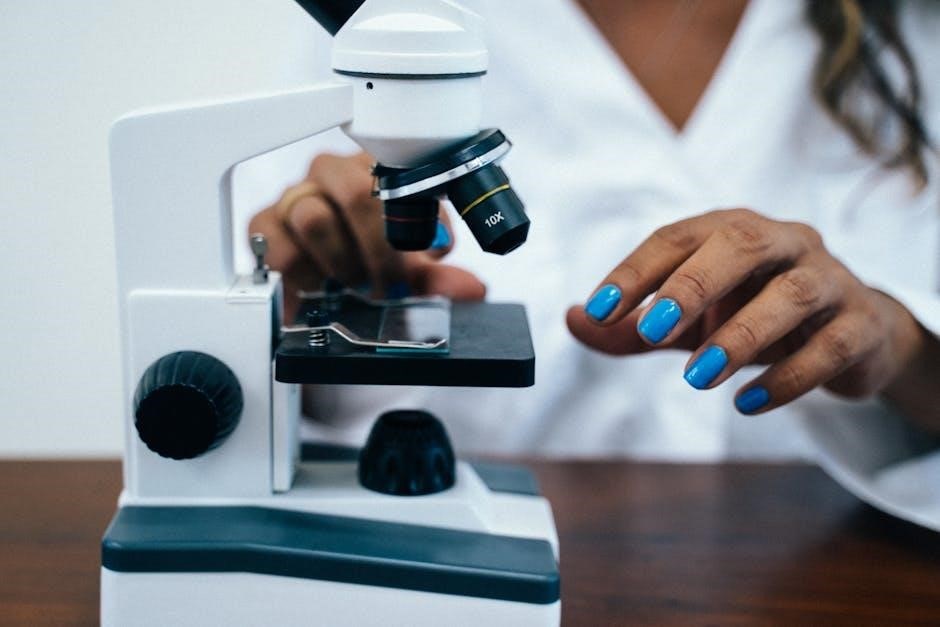
Safety Precautions in Biology Labs
Biology labs require strict adherence to safety protocols, including wearing PPE, proper handling of biological and chemical materials, and following waste disposal guidelines to ensure a secure environment․
6․1 Handling Biological Specimens
Proper handling of biological specimens is crucial to ensure safety and prevent contamination․ Always wear gloves, lab coats, and eye protection when working with biological materials․ Follow specific protocols for handling tissues, cultures, or organisms, and ensure all instruments are sterilized․ Dispose of biological waste in designated biohazard containers, and decontaminate surfaces using appropriate disinfectants․ In case of exposure, wash the affected area immediately and report incidents․ Adherence to these precautions minimizes risks and maintains a safe laboratory environment for everyone involved in the experiments․
6․2 Chemical Safety and Waste Disposal
Chemical safety and proper waste disposal are essential in biology labs to prevent accidents and environmental harm․ Always read safety data sheets (SDS) before handling chemicals, and use personal protective equipment (PPE) such as gloves and goggles․ Label all chemical containers clearly and store them in appropriate areas․ Dispose of hazardous waste in designated containers, separating recyclable and non-recyclable materials․ Follow institutional guidelines for waste disposal and attend safety training sessions regularly․ Proper chemical management ensures a safe working environment and compliance with environmental regulations․
6․3 Emergency Procedures
Emergency procedures in biology labs ensure quick and effective responses to accidents․ Familiarize yourself with the location of emergency exits, fire extinguishers, and first aid kits․ In case of chemical spills, contain the area and use absorbent materials․ For fires, evacuate the room and activate the fire alarm․ If exposed to harmful substances, flush with water and seek medical help․ Know the proper use of eye wash stations and emergency showers․ Regular drills and clear communication ensure preparedness․ Always follow lab-specific protocols and stay calm during emergencies to prioritize safety and minimize risks․
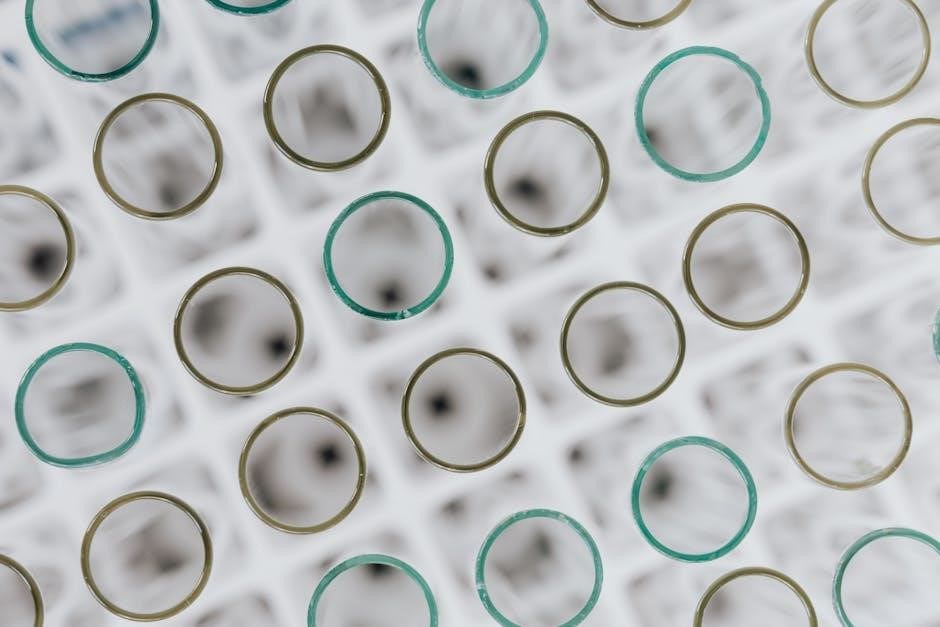
Molecular Biology Techniques
Molecular biology techniques explore DNA, RNA, and proteins․ Key methods include PCR, DNA typing, and protein analysis․ These tools enable genetic research and cellular function studies․
7․1 PCR and DNA Typing
Polymerase Chain Reaction (PCR) is a cornerstone of molecular biology, enabling the amplification of specific DNA sequences․ This technique uses thermal cycling to replicate DNA, producing millions of copies from a small sample․ PCR is essential in genetics, forensic analysis, and disease diagnostics․ DNA typing involves analyzing specific genetic markers to identify individuals or study genetic diversity․ By combining PCR with electrophoresis or sequencing, scientists can determine unique DNA profiles, making it a powerful tool in research, criminal investigations, and personalized medicine․
7․2 Cell Division and Microscopy
Cell division is a fundamental biological process studied extensively in labs․ Microscopy allows detailed observation of mitotic stages, from prophase to telophase․ Lab exercises often involve preparing and staining specimens to visualize chromosomal behavior․ Students learn to identify phases under a microscope, reinforcing concepts of cell cycle regulation․ Practical applications include analyzing the effects of chemicals on mitosis․ This hands-on approach enhances understanding of cellular dynamics, linking microscopy skills to broader biological principles․ Safe handling of microscopes and specimens is emphasized, ensuring accurate observations and data collection․
7․3 Protein Analysis and Enzyme Studies
Protein analysis and enzyme studies are central to molecular biology․ Labs often involve techniques like gel electrophoresis to separate proteins by size and chromatography for purification․ Enzyme assays measure catalytic activity, exploring factors like pH, temperature, and substrate concentration․ Students investigate enzyme kinetics, including Michaelis-Menten kinetics and inhibition types․ These exercises integrate biochemical principles with practical skills, emphasizing data collection and interpretation․ Safety protocols and proper handling of biochemical reagents are stressed, preparing students for advanced research in fields like biochemistry and biotechnology․
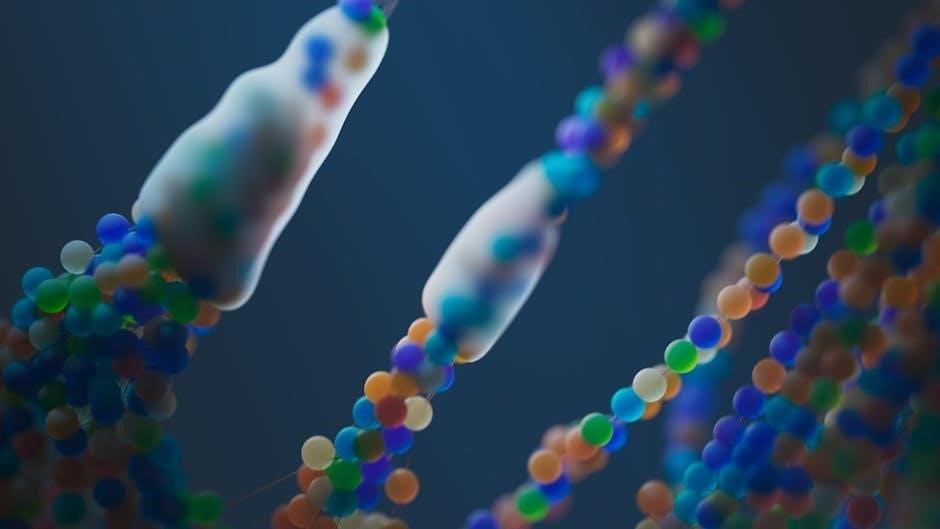
Lab Manual Design and Customization
Lab manuals can be tailored to meet specific educational needs, offering customizable activities, multimedia integration, and assessments to enhance student engagement and understanding of biological concepts․
8․1 Tailoring Labs for Specific Courses
Lab manuals can be customized to align with specific course objectives, ensuring relevance and depth․ For example, a lab manual for non-majors might focus on real-world applications, while one for majors could emphasize advanced techniques․ Customization allows instructors to select activities that match curriculum goals, such as genetics, ecology, or microbiology․ Multimedia integration, pre-lab questions, and assessments can be tailored to enhance student engagement and understanding․ This personalized approach ensures labs are meaningful and aligned with course outcomes, fostering a more effective learning experience for students․
8․2 Integrating Real-Life Applications
Lab manuals now often incorporate real-life scenarios to make learning relatable and practical․ For instance, experiments on DNA analysis or environmental studies connect classroom concepts to everyday life․ This approach helps students understand the relevance of biology in fields like medicine, conservation, and agriculture․ By linking lab activities to real-world issues, such as genetic testing or climate change, students develop a deeper appreciation for scientific applications, fostering critical thinking and problem-solving skills․ This integration bridges academic knowledge with practical, real-world experiences, enhancing overall comprehension and engagement;
8․3 Digital and Interactive Resources
Modern biology lab manuals often include digital and interactive resources to enhance learning․ These resources may include video tutorials, virtual lab simulations, and online quizzes․ Digital platforms provide students with flexible access to materials, allowing for self-paced learning․ Interactive tools, such as 3D models and animations, help visualize complex biological processes․ Additionally, some manuals offer downloadable worksheets and data analysis software․ These resources not only engage students but also provide opportunities for collaborative learning and real-time feedback, making the educational experience more dynamic and effective․ This integration of technology fosters a deeper understanding of biological concepts․
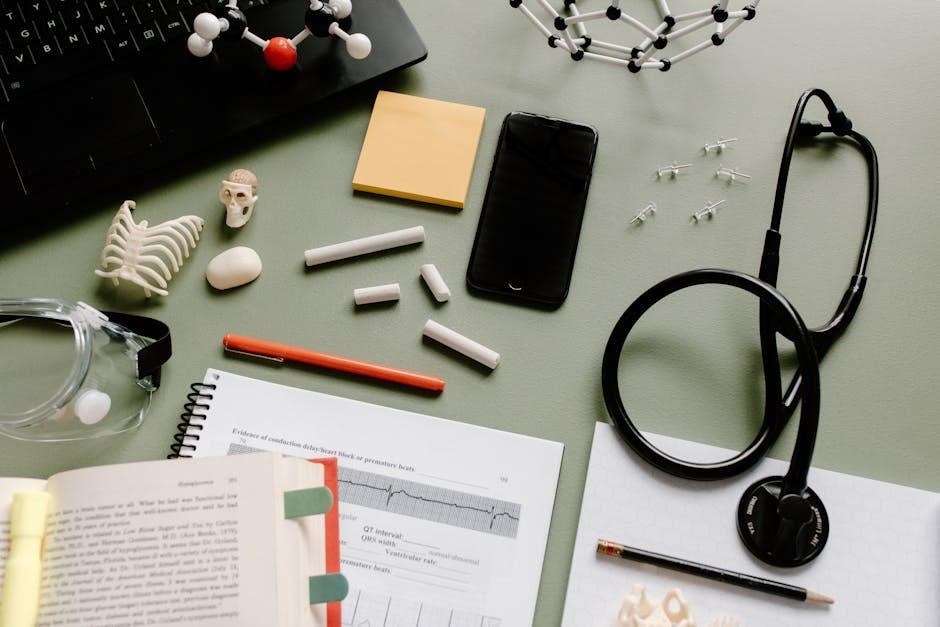
Case Studies and Practical Exercises
Case studies and practical exercises provide real-world applications of biological concepts, enabling students to investigate phenomena through hands-on activities and develop critical thinking skills in diverse biological contexts․
9․1 Human Biology and Physiology
Human biology and physiology labs focus on understanding the structure and function of the human body․ Practical exercises include measuring blood pressure, analyzing reflexes, and studying sensory responses․ Students explore physiological processes like digestion, circulation, and respiration through hands-on activities․ These exercises often incorporate real-life applications,such as assessing genetic traits or conducting DNA analysis․ Lab manuals provide detailed procedures, safety guidelines, and data interpretation techniques, enabling students to gain insights into human health and disease mechanisms․ These exercises foster critical thinking and prepare students for advanced studies in medical and life sciences․
9․2 Plant Diversity and Ecology
Plant diversity and ecology labs explore the classification, structure, and function of various plant species and their interactions with the environment․ Activities include identifying plant specimens, studying photosynthesis, and analyzing soil composition․ Students investigate ecological principles such as biodiversity, succession, and energy flow through hands-on experiments․ Lab manuals provide exercises on plant anatomy, growth measurements, and environmental impact assessments․ These practical exercises enhance understanding of ecosystems and promote skills in data collection and analysis, fostering a deeper appreciation for botanical science and conservation․
9․3 Microbiology and Pathogen Studies
Microbiology and pathogen studies in lab manuals focus on exploring microbial diversity, identification, and their roles in ecosystems and diseases․ Labs include activities like aseptic techniques, staining methods, and culturing microorganisms․ Students investigate bacterial structure, antibiotic resistance, and pathogen transmission․ Exercises emphasize safety protocols, data analysis, and real-world applications in public health․ These studies enhance understanding of microbial interactions and prepare students for careers in medicine, environmental science, and research․
Synthetic Biology and Modern Techniques
Synthetic biology lab manuals explore genetic circuit design and organism engineering․ They offer practical experiences with CRISPR, metabolic engineering, and other cutting-edge methods․
Synthetic biology is an emerging field that merges biology with engineering, focusing on the design and construction of new biological systems․ Lab manuals in this area introduce students to genetic circuit design, CRISPR-based genome editing, and bioinformatics tools․ These resources provide hands-on experiences with modern techniques, enabling students to engineer organisms for specific purposes, such as producing biofuels or medical compounds․ The manuals also emphasize ethical considerations and safety protocols, preparing learners for cutting-edge research and real-world applications in biotechnology and medicine․
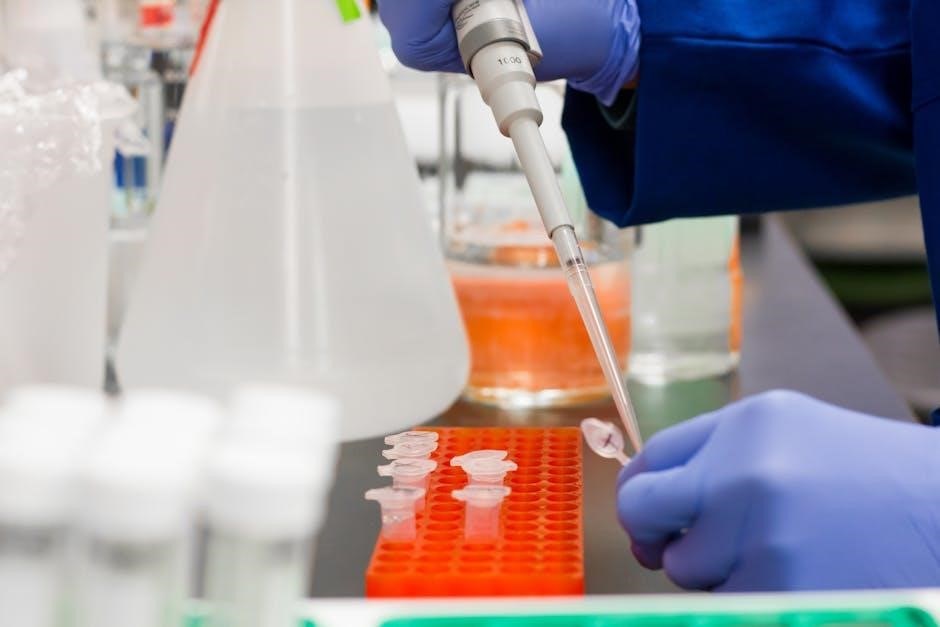
10․2 Advanced Laboratory Protocols
Advanced laboratory protocols in synthetic biology involve complex techniques such as CRISPR genome editing, gene synthesis, and bioinformatics for designing genetic circuits․ These protocols enable precise manipulation of biological systems to create novel functions․ Lab manuals detail step-by-step procedures for constructing bio-based solutions, such as biomanufacturing compounds or developing diagnostic tools․ They emphasize rigorous safety measures and ethical considerations, ensuring responsible innovation․ These protocols prepare students for cutting-edge research and real-world applications in biotechnology, medicine, and environmental science, fostering expertise in modern biological engineering․
10․3 Ethical Considerations in Modern Biology
Ethical considerations in modern biology address the moral implications of scientific advancements, such as genetic engineering, synthetic biology, and biotechnology․ Lab manuals emphasize responsible research practices, ensuring adherence to ethical standards and regulatory frameworks․ Issues like biosecurity, privacy concerns, and potential misuse of biological technologies are critically examined․ These manuals guide students to evaluate the societal and environmental impacts of their work, fostering a balanced approach to scientific progress and ethical responsibility․
